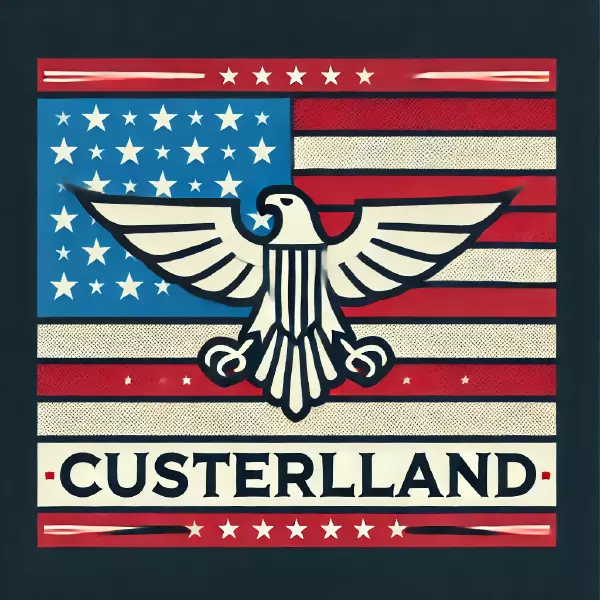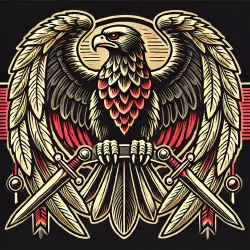This nation is in Vacation Mode for the next 863 turns. This nation cannot be attacked or traded with during that time.
| National Factbook |
| Flag: |

|
| Nation Name: |
Custerland |
| Leader Name: |
H2o |
| Currency: |

Falcon Crown |
| National Animal: |

Falcon |
| History: |
Custerland, a nation once torn apart by internal strife and foreign invasion, had long been a land of chaos and division. For generations, its people had endured the brutality of warlords who vied for control, each one more ruthless than the last. The land, though rich in resources, was impoverished by the constant conflict, and the people had grown weary of the endless cycle of violence.
In this fractured land, a figure emerged who would forever change the course of Custerland’s history. Known only by his codename, H2O, this enigmatic leader rose from the ashes of a forgotten rebellion to become the architect of a unified and powerful state. His real name was lost to history, but H2O became a symbol of strength, strategy, and ruthlessness—a leader who would stop at nothing to forge a new Custerland.
The Rise of H2O
H2O’s rise to power began in the underground resistance movements that had formed in response to the brutality of the warlords. These movements were scattered and disorganized, but they shared a common goal: to overthrow the tyrants who ruled their lands. H2O, a former soldier and brilliant strategist, recognized the potential of these groups. He knew that alone, they could achieve little, but united under a single banner, they could change the fate of the nation.
H2O began to gather support from various factions, using his charisma and vision to unite them. He promised them not just freedom from the warlords, but a new era of strength and prosperity. His message resonated with the people, and soon, he had amassed a loyal following. He adopted the falcon as his symbol—a bird of prey, representing precision, speed, and lethal force. The falcon would come to embody everything H2O stood for. |
| Geography |
| Continent: |
Africa |
| Land Area: |
69,201.62 sq. km |
| Terrain: |
|
| Highest Peak: |
,
0 meters
|
| Lowest Valley: |
,
0 meters
|
| Climate: |
|
| People & Society |
| Population: |
913,641 people |
| Demonym: |
Custerlander |
| Demonym Plural: |
Custerlanders |
| Ethnic Groups: |
- 0.0% |
| Languages: |
Custerian - 72.0%
Falconian - 26.5% |
| Religions: |
- 0.0% |
| Health |
| Life Expectancy: |
87 years |
| Obesity: |
4.5% |
| Alcohol Users: |
0.9% |
| Tobacco Users: |
23% |
| Cannabis Users: |
0% |
| Hard Drug Users: |
0.1% |
| Economy |
| Description: |
The Chaos Before H2O
Before H2O's rise, Custerland was a land divided. The country’s resources were plentiful, but they were controlled by various warlords who exploited them for their own gain. The economy was in shambles—trade was almost nonexistent, infrastructure was in ruins, and the people were impoverished. The warlords taxed their territories heavily, with little to show for it, as most of the wealth was funneled into their private armies. Meanwhile, the common people struggled to survive, their livelihoods destroyed by the constant warring.
In this environment of chaos and despair, H2O saw an opportunity. He understood that true power came not just from military strength, but from economic stability and growth. A nation with a strong economy could sustain a powerful military, support its population, and expand its influence beyond its borders. H2O’s vision for Custerland was not just as a dominant military power, but as an economic force to be reckoned with.
Consolidating Power: The Foundation of Economic Control
The first step in H2O’s economic plan was to consolidate power. As he began to unite the warring states under his rule, he systematically dismantled the corrupt systems of the warlords. He seized control of their wealth, which had been hoarded in secret vaults, and redistributed it to fund the rebuilding of Custerland’s infrastructure. Roads, bridges, and communication networks were constructed to reconnect the disparate regions of the country. This infrastructure was vital not only for military movement but also for trade and economic growth.
H2O understood the importance of centralizing economic power. He established a national treasury, placing all financial resources under the control of the state. This allowed him to regulate the flow of money within the economy, ensuring that it was used efficiently to rebuild the nation. The warlords’ private treasuries were nationalized, and their wealth was used to stabilize the economy. H2O introduced a new currency, the Falconmark, which was quickly adopted across the nation. The Falconmark became a symbol of unity and stability, replacing the various currencies that had been used by the warlords. |
| Average Yearly Income: |
$147.42 |
| Gross Domestic Product (GDP): |
$1,104,676,326.00 |
| GDP per Capita: |
$1,209.09 |
| Gross National Income (GNI): |
$511,073,000.00 |
| Industries: |
Industrialization: The Engine of Economic Growth
With his control over the economy firmly established, H2O turned his attention to industrialization. He knew that a strong industrial base was essential for economic growth and military power. Custerland was rich in natural resources, including iron, coal, and precious metals, but these resources had been underutilized due to the constant warfare. H2O saw the potential to transform Custerland into an industrial powerhouse.
H2O initiated a series of ambitious industrial projects, focusing on sectors that would support both the economy and the military. He built factories to produce weapons, ammunition, and military vehicles, ensuring that Custerland's armed forces were well-equipped. At the same time, he invested in industries that would drive economic growth, such as steel production, mining, and manufacturing. These industries provided jobs for thousands of Custerland’s citizens, helping to reduce unemployment and stimulate economic activity.
To ensure the success of his industrialization efforts, H2O established strict control over the workforce. He implemented a system of labor conscription, where citizens were required to work in state-owned factories and mines for a set period. This system was not without its detractors, but H2O’s iron-fisted rule ensured compliance. The state provided housing, food, and basic healthcare to the workers, which, while minimal, was an improvement over the destitution many had faced under the warlords. In return, the workers were expected to meet rigorous production quotas, which fueled the rapid growth of Custerland’s industrial sector.
Agricultural Reforms: Feeding the Nation
While industrialization was a key component of H2O’s economic strategy, he also recognized the importance of agriculture. Custerland’s farmlands had been ravaged by war, and food shortages were common. H2O knew that a hungry population would be difficult to control, so he implemented a series of agricultural reforms to ensure that the nation could feed itself.
H2O’s first move was to collectivize agriculture. He seized control of the large estates that had been owned by the warlords and redistributed the land to create state-run farms. These collective farms were managed by the state, which provided the seeds, tools, and livestock necessary for farming. The farmers, who had previously been serfs or laborers under the warlords, were now employees of the state, receiving a steady wage and basic provisions in exchange for their labor.
The state-run farms were organized to maximize efficiency. H2O brought in agricultural experts to teach modern farming techniques, such as crop rotation, irrigation, and the use of fertilizers. The farms were also mechanized, with tractors and other machinery provided by the state to increase productivity. These reforms led to a significant increase in agricultural output, and within a few years, Custerland was not only able to feed its population but also to export surplus food to neighboring countries.
The success of the agricultural reforms had a ripple effect throughout the economy. The increased food supply helped stabilize the population, reducing hunger and improving health. It also freed up labor for the industrial sector, as fewer people were needed to work the land. Additionally, the export of surplus food provided a valuable source of income for the state, which was reinvested in further industrial and infrastructure projects.
Trade and Commerce: Opening Custerland to the World
With the foundations of the economy firmly in place, H2O turned his attention to trade and commerce. He knew that for Custerland to truly prosper, it needed to engage with the outside world. However, the nation’s history of conflict had left it isolated, with few trading partners and a reputation for instability. H2O set out to change that.
The first step was to establish secure trade routes. The newly built infrastructure allowed for the efficient movement of goods within Custerland, but H2O also needed to ensure that these goods could reach foreign markets. He ordered the construction of ports and shipping facilities along Custerland’s coastline, which were protected by the Falcon Fleet. The Falcon Fleet, under the command of Admiral Theon ‘Sea Hawk’ Vectis, ensured that Custerland’s ships could sail safely, free from the threat of piracy or foreign interference.
H2O also negotiated trade agreements with neighboring countries. He used Custerland’s newfound military power as leverage, offering protection and security in exchange for favorable trade terms. These agreements allowed Custerland to export its surplus agricultural products, as well as manufactured goods, to foreign markets. In return, Custerland imported raw materials that were scarce within its borders, such as oil and rubber, which were essential for its growing industrial sector.
To encourage internal commerce, H2O established a network of state-run banks that provided loans and financial services to businesses. These banks were designed to support the growth of small and medium-sized enterprises, which were seen as vital to the nation’s economic development. H2O also implemented a strict regulatory framework to ensure that businesses operated in accordance with state goals. Corruption was dealt with harshly, and businesses that failed to meet production targets or engaged in illicit activities were quickly shut down. |
| Military |
| History: |
H2O’s first priority was to establish a disciplined and loyal military force that could challenge the warlords. He knew that to defeat the fragmented armies of Custerland, he needed a force that was both elite and versatile. Thus, the Falcon Guard was born. The Falcon Guard was not just a fighting force; it was an ideal. Soldiers were selected not only for their combat skills but for their loyalty and belief in H2O’s vision.
The Falcon Guard was trained to the highest standards. H2O personally oversaw their training, ensuring that they were not only skilled warriors but also masters of strategy and deception. They were taught to strike swiftly and without warning, much like the falcon they were named after. Clad in uniforms of black and gold, the colors of the falcon, the Falcon Guard became the spearhead of H2O’s military campaign.
H2O’s strategy was one of attrition and psychological warfare. He knew that the warlords were not only strong but also deeply paranoid. He used this to his advantage, spreading rumors and misinformation to sow discord among them. The Falcon Guard struck at the most opportune moments, exploiting the weaknesses of the warlords and turning them against one another. Within a few years, H2O had systematically dismantled the power of the warlords, bringing large swathes of Custerland under his control. |
| Soldiers: |
0 |
| Tanks: |
0 |
| Aircraft: |
0 |
| Ships: |
0 |
| Missiles: |
0 |
| Nuclear Weapons: |
0 |
| Last Updated: 09/10/2024 03:50 pm |













